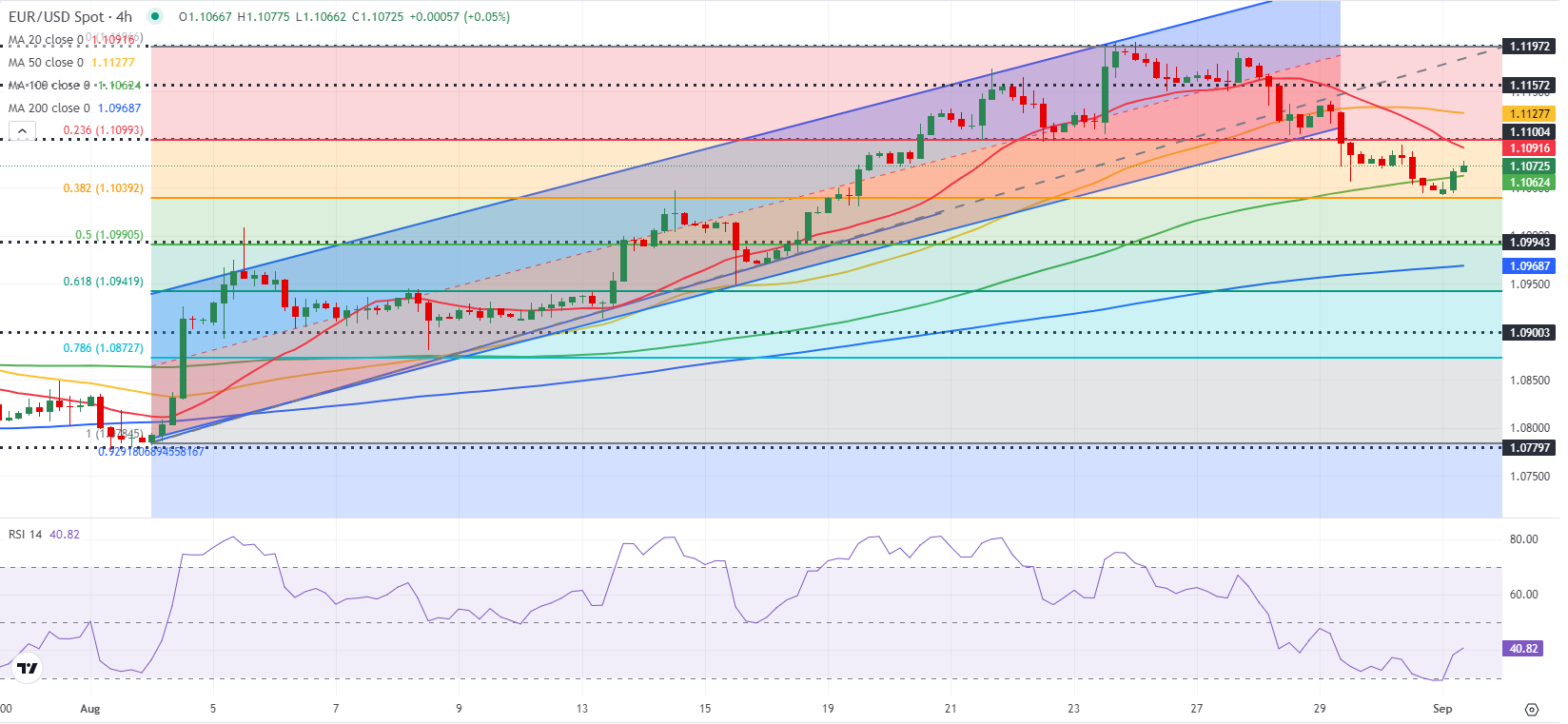- EUR/USD recovers modestly in the European session on Monday.
- Financial markets in the US will remain closed in observance of the Labor Day holiday.
- The near-term technical outlook is yet to point to a bullish tilt.
EUR/USD spent the second half of the previous week under strong bearish pressure and closed deep in negative territory in three consecutive days. After losing over 1% on a weekly basis, the pair stages a technical correction and trades above 1.1050 in the European morning on Monday.
The US Dollar (USD) preserved its strength ahead of the weekend as markets paid little to no attention to the Personal Consumption Expenditures (PCE) Price Index figures for July.
The US Bureau of Economic Analysis reported that the annual PCE inflation held steady at 2.5%. Meanwhile, the core PCE Price Index, which excludes volatile food and energy prices, rose 0.2% on a monthly basis, as expected.
Bond and stock markets in the US will remain closed in observance of the Labor Day holiday on Monday. Hence, the trading action is likely to turn subdued in the second half of the day.
The US economic docket will feature ISM Manufacturing PMI for August on Tuesday. Later in the week, investors will have more data releases to assess from the US, including ISM Services PMI and August jobs report.
EUR/USD Technical Analysis
EUR/USD started to edge higher after coming in within a touching distance of 1.1040, where the Fibonacci 38.2% retracement of the latest uptrend is located. At the time of press, the pair was trading a few pips above the 100-period Simple Moving Average (SMA) on the four-hour chart, currently aligning at around 1.1060. In case the pair confirms this level as support, 1.1100 (Fibonacci 23.6% retracement, static level) could be seen as next resistance before 1.1130 (50-period SMA).
On the downside, a drop below 1.1060 (100-period SMA) could open the door for another test of 1.1040. Once that support fails, technical sellers could show interest. In this scenario, 1.1000 (psychological level, Fibonacci 50% retracement) could be seen as the next bearish target.
Euro FAQs
The Euro is the currency for the 20 European Union countries that belong to the Eurozone. It is the second most heavily traded currency in the world behind the US Dollar. In 2022, it accounted for 31% of all foreign exchange transactions, with an average daily turnover of over $2.2 trillion a day. EUR/USD is the most heavily traded currency pair in the world, accounting for an estimated 30% off all transactions, followed by EUR/JPY (4%), EUR/GBP (3%) and EUR/AUD (2%).
The European Central Bank (ECB) in Frankfurt, Germany, is the reserve bank for the Eurozone. The ECB sets interest rates and manages monetary policy. The ECB’s primary mandate is to maintain price stability, which means either controlling inflation or stimulating growth. Its primary tool is the raising or lowering of interest rates. Relatively high interest rates – or the expectation of higher rates – will usually benefit the Euro and vice versa. The ECB Governing Council makes monetary policy decisions at meetings held eight times a year. Decisions are made by heads of the Eurozone national banks and six permanent members, including the President of the ECB, Christine Lagarde.
Eurozone inflation data, measured by the Harmonized Index of Consumer Prices (HICP), is an important econometric for the Euro. If inflation rises more than expected, especially if above the ECB’s 2% target, it obliges the ECB to raise interest rates to bring it back under control. Relatively high interest rates compared to its counterparts will usually benefit the Euro, as it makes the region more attractive as a place for global investors to park their money.
Data releases gauge the health of the economy and can impact on the Euro. Indicators such as GDP, Manufacturing and Services PMIs, employment, and consumer sentiment surveys can all influence the direction of the single currency. A strong economy is good for the Euro. Not only does it attract more foreign investment but it may encourage the ECB to put up interest rates, which will directly strengthen the Euro. Otherwise, if economic data is weak, the Euro is likely to fall. Economic data for the four largest economies in the euro area (Germany, France, Italy and Spain) are especially significant, as they account for 75% of the Eurozone’s economy.
Another significant data release for the Euro is the Trade Balance. This indicator measures the difference between what a country earns from its exports and what it spends on imports over a given period. If a country produces highly sought after exports then its currency will gain in value purely from the extra demand created from foreign buyers seeking to purchase these goods. Therefore, a positive net Trade Balance strengthens a currency and vice versa for a negative balance.
Information on these pages contains forward-looking statements that involve risks and uncertainties. Markets and instruments profiled on this page are for informational purposes only and should not in any way come across as a recommendation to buy or sell in these assets. You should do your own thorough research before making any investment decisions. FXStreet does not in any way guarantee that this information is free from mistakes, errors, or material misstatements. It also does not guarantee that this information is of a timely nature. Investing in Open Markets involves a great deal of risk, including the loss of all or a portion of your investment, as well as emotional distress. All risks, losses and costs associated with investing, including total loss of principal, are your responsibility. The views and opinions expressed in this article are those of the authors and do not necessarily reflect the official policy or position of FXStreet nor its advertisers. The author will not be held responsible for information that is found at the end of links posted on this page.
If not otherwise explicitly mentioned in the body of the article, at the time of writing, the author has no position in any stock mentioned in this article and no business relationship with any company mentioned. The author has not received compensation for writing this article, other than from FXStreet.
FXStreet and the author do not provide personalized recommendations. The author makes no representations as to the accuracy, completeness, or suitability of this information. FXStreet and the author will not be liable for any errors, omissions or any losses, injuries or damages arising from this information and its display or use. Errors and omissions excepted.
The author and FXStreet are not registered investment advisors and nothing in this article is intended to be investment advice.
Recommended Content
Editors’ Picks

EUR/USD holds ground above 1.1050 as USD struggles
EUR/USD is holding gains above 1.1050 in the European trading on Monday. A pause in the US Dollar recovery helps the pair stay afloat even though markets appear cautious ahead of key US employment data releases later this week. US Labor Day-led thin trading will likely extend.

GBP/USD stays firm near 1.3150 amid light trading
GBP/USD remains bid near 1.3150 in the European session on Monday amid the US Labor Day-led thin liquidity. In the absence of top-tier economic data releases from the UK this week, the US Dollar price dynamic will be the main driver for the GBP/USD.

Gold trades in tight range as upside looks capped by USD recovery
Gold (XAU/USD) continues trading in a familiar range just above $2,500 on Monday even as Asian stocks fall due to China-growth fears following the release of mixed Manufacturing Purchasing Managers Index (PMI) data.

Tron price is set for a decline as technical indicators show bearish momentum
Tron (TRX) retested its resistance barrier and declined 6.1% last week. In the Asian session on Monday, it trades at $0.1557. Tron's price action suggests a decline ahead, as the bearish divergence in technical indicators shows.

Week ahead: US labour data and the BoC rate announcement in focus
With US Federal Reserve Chair Jerome Powell’s recent speech at the Jackson Hole Symposium confirming that it is time to begin easing policy as well as underlining the importance of the jobs market, this week’s jobs data may help determine how the Fed approaches its easing cycle.

Moneta Markets review 2024: All you need to know
VERIFIED In this review, the FXStreet team provides an independent and thorough analysis based on direct testing and real experiences with Moneta Markets – an excellent broker for novice to intermediate forex traders who want to broaden their knowledge base.
